Even at a salad bar, there are plenty of dietary land mines among the healthier choices. Prepared salads, oily croutons and ladles of dressing can easily add up to 1,000 calories or more, not to mention countless grams of fat (and sodium).
7 Common Salad Bar Mistakes and How to Fix Them
If you want to reap the most benefits on your next trip to the salad bar, follow the tips below. Here you'll find ways to create a delicious, nutritious salad while minding your waistline at the same time.1. Build your base with veggies
Start by filling your plate with salad greens and plenty of raw veggies. Your salad should be 80 percent to 90 percent raw vegetables.- An easy way to make sure you have a good load of nutrients is to pick vegetables with different colors. You won't be doing yourself a favor if your salad consists of iceberg lettuce and a couple of cucumbers.
- Get your greens with spinach, broccoli, cucumbers, celery and green peppers. Add some reds with tomatoes, beets and peppers. Toss in the yellows with summer squash or bell peppers. Mix in orange carrots, purple shredded cabbage and white or gray mushrooms.
- If they are available, add roasted red peppers, which are fat-free and loaded with flavor.
2. Avoid prepared salads, such as tuna, chicken, potato and macaroni salad.
- These items are often loaded with full-fat mayonnaises and oils.
- Just a half cup serving can average 10 grams of fat and almost 200 calories.
3. Be creative with marinated veggies
Items such as three bean salad, artichoke hearts or marinated cucumbers and tomatoes are okay in small amounts. A small spoonful of any one of these (or a combo) can act as all or part of your salad dressing. This will add a wonderful flavor to the salad.4. Enjoy lean proteins
If the salad is your main meal, lean proteins are a must.- Plain cut-up turkey or chicken breast, cubed tofu, cottage cheese, undressed tuna fish or hardboiled eggs are all good choices.
- Plain chickpeas and beans also deliver on protein, and are high in fiber to boot (5 to 7 grams per half cup).
5. Go easy on the toppings
Go light on calorie-dense foods or avoid them altogether. Items such as cheeses, croutons and bacon should be limited or avoided.Feel free to sprinkle tiny portions of nuts, seeds or olives, which will offer a dose of healthy fat and add some fun crunch and flavor.
6. Ditch the dressing
A good salad does not need to be drowned in dressing.- Just two tablespoons of a full-fat dressing can cost you 150 calories and 15 grams of fat. A typical ladle at a salad bar holds 4 tablespoons.
- Fat-free dressings will be lower in fat and calories, but often full of sugar and other additives.
- Instead, use small amounts of marinated veggies or beans, which will help dress your salad without going overboard.
- Also, most salad bars have the option of plain olive oil and vinegar. Try just drizzling on a little olive oil - and be generous with the vinegar.
- Top your salad with just a dash of Parmesan cheese for extra kick and flavor.
